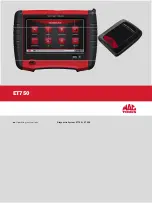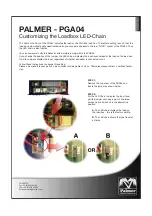
TB-3014
Page 5 of 7
DESCO WEST
- 3651 Walnut Avenue, Chino, CA 91710 • (909) 627-8178
DESCO EAST
- One Colgate Way, Canton, MA 02021-1407 • (781) 821-8370 • Website:
Per ANSI/ESD 7.1 (Floors) Report:
• Rtg all values in ohms for resistance-to-ground
• Rtt all values in ohms for point-to-point resistance
• Voltage level
• Test date
• Temperature
• Relative humidity
• Test equipment used
Summarize test data by reporting minimum, maximum,
median, and mean values obtained. Include a diagram
showing approximate electrode positions and ground
connections used.
Recommended Frequency of Periodic Checks
of Installed Products
Note: “The frequency of periodic testing is normally
specified in corporate operating procedures. …The
frequency of testing is driven by the amount of risk
exposure that can occur between tests. For, example, what
is the quantity of product handled between test periods?”
(See ESD Handbook ESD TR20.20) However, a common
guide would be:
•
Worksurface
- at least quarterly (see ESD TR20.20
section 5.3.1.13 Periodic Tests)
•
Footwear
- “Incoming inspection on a lot sampling basis
should be performed for all static control footwear.” (see
ESD TR20.20 section 5.3.3.4 Testing)
•
Floor
- “The types of monitoring and type of equipment
are considerations. In some cases, a simple electrical
resistance test with a megohmmeter may suffice. In
others, a static charge generation test may be required.”
(see ESD TR20.20 section 5.3.4.13 Performance
Monitoring)
•
Seating
- “The recommended electrical resistance range
for seating is less than 1 x 10E9 ohms as tested in
accordance with ANSI/ESD STM 12.1. This value should
be during acceptance testing, installation and periodically
thereafter.” (see ESD TR20.20 section 5.3.5.3 Testing)
•
Garments
- “To maintain process control, it is imperative
that the garment be tested per ANSI/ESD STM 2.1. The
point-to-point and sleeve-to-sleeve resistance test should
be made.” (see ESD TR20.20 section 5.3.13.3.1.8
Periodic Testing)
Surface Resistivity
Theoretically Resistivity is 10 times greater than Resistance,
i.e. a material that measures 10E7 ohms surface resistance,
Surface Resistivity should measure 10E8 ohms/square.*
Ref: ANSI/ESD S11.11 section 12.0 Conversion to
Resistivity states, “When it is appropriate to convert a
resistance obtained by this test method to an equivalent
resistivity in ohms per square, multiply the resistance
measurements obtained by this method by 10. The
conversion factor of 10 is derived from the geometry of the
electrode assembly.”
No conversion is required with the Surface Resistance Test
Kit. The Meter incorporates provision to install an optional
Resis tivity Attachment which has parallel electrodes
on bottom of the unit to make direct surface resistivity
measurements. These parallel electrodes allow for
measurement of resistivity or when quick checks without the
use of 5 pound electrodes is desired.
*Note: Although S11.11-1993 uses ohms/square, per ESD
TR20.20, the correct unit of measure for resistivity is just
ohms.
Battery Life:
Approximately 1,500 measurements
Resistivity Electrodes: Two parallel conductive silicone
rubber electrodes (optional item)
External Electrodes:
Two 5 pound (±2 oz) weighted
electrodes, 2.5” in diameter, complies with ANSI/ESD S4.1
Display:
One 3.5 digit .500” Liquid Crystal Display (LCD)
Display and seventeen Light Emitting Diodes (LED’s)
illuminate exponent numbers function being performed.
*
Accuracy:
Resistance measurements within ±10% (E11
& greater ±20%), complies with ANSI/ESD-S4.1. Under
load voltages of 10 volts ± 5% and 100 volts ± 5% exceeds
requirements of ANSI/ESD-S4.1
Meter Weight:
15.5 oz.
Dimensions:
8"L x 4.3"W x 1.6"H
Test Button: Press the red test button for 15-20 second
electrification period. Meter will immediately display surface
resistance exponent via LED. LCD will display temperature
(both Fahrenheit & Celsius), then humidity, and after taking
numerous readings and making numerous calculations
display surface resistance mantissa.
Note: Reporting test results, you may want to record the
resistance, humidity, temperature, and test voltage.
Maintenance
Your Surface Resistance Test Kit will require little
maintenance, and there are no user serviceable parts. If
your Meter requires service beyond cleaning the Electrodes
or replacing the batteries, please contact the factory.
This product utilizes a high frequency switching circuit to
step up the 3 volts from the batteries to the 100 volt test
level. Some users are able to discern a slight hum or
buzzing. This is perfectly normal and is not considered a
flaw or defect.
*
Testing / Verification
The Surface Resistance Test Kit is calibrated to NIST
traceable standards. Most users require calibration
annually. Please call our Customer Service Department at
909-627-8178 (Chino, CA) or 781-821-8370 (Canton, MA)
for details. In-house calibration can be performed by using
1% resistors in each of the meter ranges. Simply attach
the resistors to the test leads using clips and recording
the meter display. Keep the test leads separated. Should
adjustment be necessary, it is recommended that the unit
be returned to the factory as access to internal adjustments
requires special equipment.
© 2013 DESCO INDUSTRIES INC.
Employee Owned


























